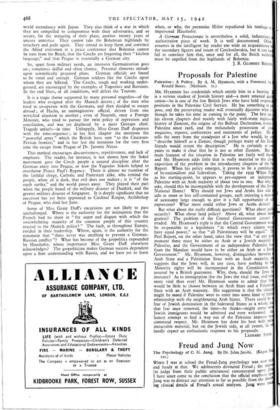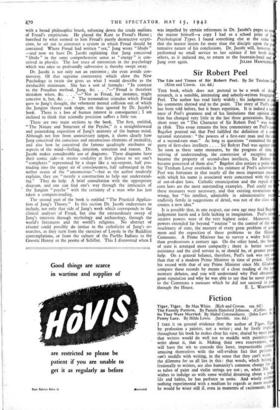Freud and Jung Now
The Psychology of C. G. Jung. By Dr. Jolan Jacobi. (Kegarl Ps x2s.) WHEN I was at school the Freud-Jung psychology was new s and heady at that. We adolescents devoured Freud • the mast (to judge from their public utterances) concentrated upon I have since come to the conclusion that the official emphasis u Jung was to distract our attention as far as possible from the abse ing clinical details of Freud's sexual analyses. Jung went
with a broad philosophic brush, softening down the crude outlines of Freud's empiricism. He played the Kant to Freud's Hume ; horrified by what seemed to him Freud's purely destructive scepti- cism, he set out to construct a system in which Freud should be contained. Where Freud had written " sex," Jung wrote " libido " —and now we have Dr. Jacobi explaining that Jung conceived " libido " in the same comprehensive sense as " energy " is con- ceived in physiCs. The last trace of extremism in the psychology which was once so profoundly subversive is thereby swept away.
Dr. Jacobi is not only not an extremist ; she even avoids con- troversy. Of that supreme controversy which dove the New Psychology in twain she gives us what I would describe as the irreducible minimum. She has a sort of formula : " In contrast to the Freudian method, Jung, &c. . . ."—" Freud is therefore mistaken when, &c. . ."—" Not as Freud, for instance, might conceive it, but, &c. . . ." The tremendous stimulus which Freud gave to Jung's thought, the vehement mental collision out of which the Jungian theory took shape, are thus ignored by Dr. Jacobi's book. There is a loss of human interest in consequence ; I am inclined to think that scientific precision suffers a little too.
There are two main sections to the book. The first, entitled, "The Nature and Structure of the Psyche," is a straightforward and painstaking exposition of Jung's anatomy of the human mind. Although not free from unnecessary jargon, it shows dearly how Jung conceived the conscious and unconscious elements of mentality, and also how he conceived the famous quadruple attributes or aspects of the mind—feeling, intuition, sensation and reason. Dr. Jacobi makes considerable use of diagrams. These diagrams have their comic side—it strains credulity at first glance to see one's " complexes " represented by a shape like a sea-serpent, half pro- truding into the upper air of consciousness, half submerged in the nether ocean of the " unconscious "—but as the author modestly explains, they are " merely a construction to help our understand- ing." They do help. A brief consultation with the appropriate diagram, and one can find one's way through the intricacies of the Jungian " psyche " with the certainty of a man who has just taken a compass-reading.
The second part of the book is entitled " The Practical Applica- tion of Jung's Theory." In this section Dr. Jacobi endeavours to include, not only that side of Jung's work which corresponds to the clinical analyses' of Freud, but also the extraordinary sweep of Jung's interests through mythology and archaeology, through the world's literatures and the world's religions. No abstract or resume could possibly do justice to the catholicity of Jung's re- searches, as they turn from the exercises of Loyola to the Buddhist contemplations, or from the culture of the Pueblo Indians to the Gnostic Heresy or the poems of Schiller. This I discovered when I
was impelled by certain references in Dr. Jacobi's pages to the master himself—a copy I had as a school prize of J Psychological Types. 1 found something else at the same t that the master insists far more than the disciple upon the p tentative nature of his conclusions. Dr. Jacobi will, however, performed no small service to her science if her book ind others, as it induced me, to return to the fountain-head and



























 Previous page
Previous page